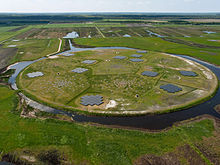
LOFAR

The Low-Frequency Array or LOFAR, is a large radio telescope network located mainly in the Netherlands, completed in 2012 by ASTRON, the Netherlands Institute for Radio Astronomy and its international partners, and operated by ASTRON's radio observatory, of the Netherlands Organisation for Scientific Research. The Low-Frequency Array or LOFAR, is a large radio telescope network located mainly in the Netherlands, completed in 2012 by ASTRON, the Netherlands Institute for Radio Astronomy and its international partners, and operated by ASTRON's radio observatory, of the Netherlands Organisation for Scientific Research. LOFAR consists of a vast array of omnidirectional antennas using a new concept in which the signals from the separate antennas are not combined in real time as they are in most array antennas. The electronic signals from the antennas are digitized, transported to a central digital processor, and combined in software to emulate a conventional antenna. The project is based on an interferometric array of radio telescopes using about 20,000 small antennas concentrated in at least 48 stations. Forty of these stations are distributed across the Netherlands and were funded by ASTRON. The five stations in Germany, and one each in Great Britain, France, Sweden and Ireland, were funded by these countries. Further stations may also be built in other European countries. The total effective collecting area is approximately 300,000 square meters, depending on frequency and antenna configuration. The data processing is performed by a Blue Gene/P supercomputer situated in the Netherlands at the University of Groningen. LOFAR is also a technology precursor for the Square Kilometre Array. LOFAR was conceived as an innovative effort to force a breakthrough in sensitivity for astronomical observations at radio-frequencies below 250 MHz. Astronomical radio interferometers usually consist either of arrays of parabolic dishes (e.g. the One-Mile Telescope or the Very Large Array), arrays of one-dimensional antennas (e.g. the Molonglo Observatory Synthesis Telescope) or two-dimensional arrays of omnidirectional antennas (e.g. Antony Hewish's Interplanetary Scintillation Array). LOFAR combines aspects of many of these earlier telescopes; in particular, it uses omnidirectional dipole antennas as elements of a phased array at individual stations, and combines those phased arrays using the aperture synthesis technique developed in the 1950s. Like the earlier Cambridge Low Frequency Synthesis Telescope (CLFST) low-frequency radio telescope, the design of LOFAR has concentrated on the use of large numbers of relatively cheap antennas without any moving parts, concentrated in stations, with the mapping performed using aperture synthesis software. The direction of observation ('beam') of the stations is chosen electronically by phase delays between the antennas. LOFAR can observe in several directions simultaneously, as long as their aggregated data rate remains under its cap. This in principle allows a multi-user operation. LOFAR makes observations in the 10 MHz to 240 MHz frequency range with two types of antennas: Low Band Antenna (LBA) and High Band Antenna (HBA), optimized for 10-80 MHz and 120-240 MHz respectively. The electric signals from the LOFAR stations are digitised, transported to a central digital processor, and combined in software in order to map the sky. Therefore, LOFAR is a 'software telescope'. The cost is dominated by the cost of electronics and will therefore mostly follow Moore's law, becoming cheaper with time and allowing increasingly large telescopes to be built. The antennas are simple enough, but there are about 20,000 in the LOFAR array. To make radio surveys of the sky with adequate resolution, the antennas are arranged in clusters (stations) that are spread out over an area of more than 1000 km in diameter. The LOFAR stations in the Netherlands reach baselines of about 100 km. LOFAR currently receives data from 24 core stations (in Exloo), 14 'remote' stations in The Netherlands and 12 international stations. Each of the core and remote stations has 48 HBA's and 96 LBA's and a total of 48 digital Receiver Units (RCU's). International stations have 96 LBA's and 96 HBA's and a total of 96 digital Receiver Units (RCU's).
